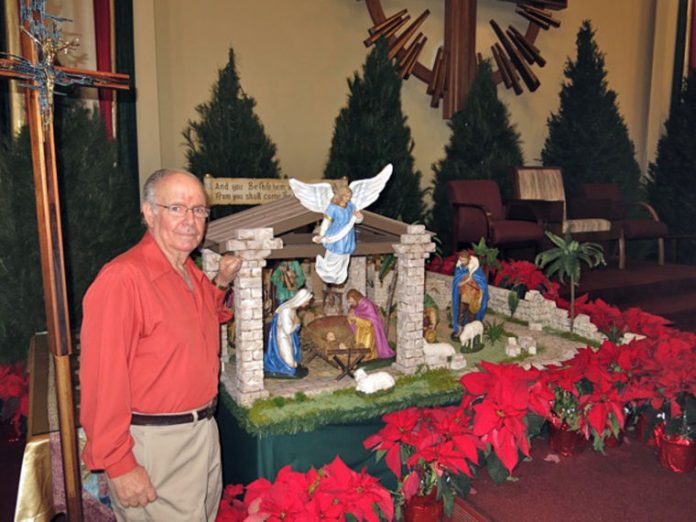
This Christmas season, parishioners of Gilroy’s St. Mary Roman Catholic Church received a special gift to enhance their worship services. Displayed beside the altar is an 8-foot square representation of Bethlehem as it may have looked at the time of Jesus’ birth.
This beautifully detailed model is the handiwork of longtime parishioner Carlos Paiva. When he was a child, he enjoyed seeing his carpenter father build similar creations; at the suggestion of some members of St. Mary’s congregation, he decided to build one himself.
Construction started in his garage in September, and it took about three months of weekends to complete. The main materials used are cardboard, styrofoam and plywood. An electrician by trade, Paiva installed tiny lights inside some of the buildings.
Every part of the city was made according to his own design, including pots near the well and palm trees. Only the human and animal figures were bought commercially. The display has ben very popular with the St. Mary community; some people even posted photos of it on Facebook. It is hoped that it will become a seasonal fixture each year.
Nativity scenes, or crèches, have become an important part of traditional Christmas decoration, rivaling Santa, Rudolf and Frosty. However, the history of the nativity scene goes back much further.
St. Francis of Assisi is credited with creating the first nativity scene in 1223 when he returned from the Holy Land inspired to help people understand the true message of Christmas that was already becoming secularized.
Francis set up a manger (feed trough used as a crib) with people representing Mary, Joseph and Jesus, as well as hay and two live animals in a cave near the Italian village of Grecio. When the villagers came to see it, he preached sermons about Jesus’ birth in Bethlehem.
During the next century, these scenes, using statues rather than live people and animals, became common in Italian churches throughout the year. The custom spread to other countries and became centered on the Advent and Christmas seasons.
Crèches can be incredibly beautiful and made from a variety of materials. For example, each December a church in Palo Alto hosts a crèche display featuring more than 350 nativities from around the world representing many different time periods (www.christmascreche.org).
Nativity scenes always include a standard cast of characters: Joseph, Mary, Baby Jesus, farm animals, shepherds and three Wise Men. However, this isn’t strictly accurate because Matthew’s gospel describes Jesus’ birth and the trip of the Wise Men to see him, while Luke’s gospel tells about only the shepherds’ visit to the manger. Nowhere in the Bible does it describe Wise Men, shepherds and farm animals all being present together.
According to Christian tradition, the Wise Men (sometimes called Magi or Three Kings) actually arrived in Bethlehem on Jan. 6. The Church made Twelfth Day a major feast, the Epiphany, and because they arrived bearing gifts for the baby Jesus, this is the major gift-giving occasion in some countries.
Epiphany is Greek for “manifestation” or “revelation,” signifying that these visitors were the first Gentiles (non-Jews) to learn of the identity of Jesus of Nazareth as the Son of God.









